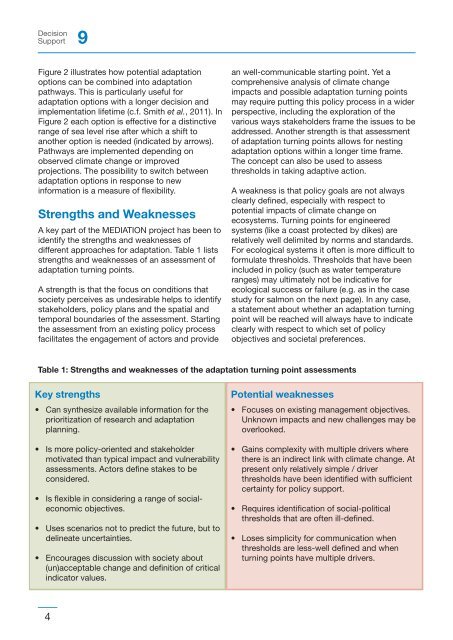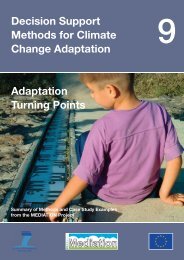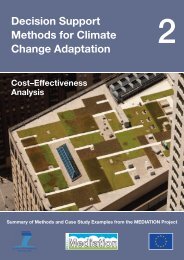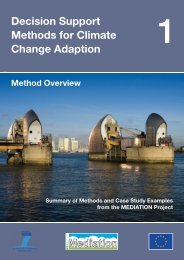Download all Technical Policy Briefing Notes in a single ... - Mediation
Download all Technical Policy Briefing Notes in a single ... - Mediation
Download all Technical Policy Briefing Notes in a single ... - Mediation
- No tags were found...
You also want an ePaper? Increase the reach of your titles
YUMPU automatically turns print PDFs into web optimized ePapers that Google loves.
DecisionSupport 9Figure 2 illustrates how potential adaptationoptions can be comb<strong>in</strong>ed <strong>in</strong>to adaptationpathways. This is particularly useful foradaptation options with a longer decision andimplementation lifetime (c.f. Smith et al., 2011). InFigure 2 each option is effective for a dist<strong>in</strong>ctiverange of sea level rise after which a shift toanother option is needed (<strong>in</strong>dicated by arrows).Pathways are implemented depend<strong>in</strong>g onobserved climate change or improvedprojections. The possibility to switch betweenadaptation options <strong>in</strong> response to new<strong>in</strong>formation is a measure of flexibility.Strengths and WeaknessesA key part of the MEDIATION project has been toidentify the strengths and weaknesses ofdifferent approaches for adaptation. Table 1 listsstrengths and weaknesses of an assessment ofadaptation turn<strong>in</strong>g po<strong>in</strong>ts.A strength is that the focus on conditions thatsociety perceives as undesirable helps to identifystakeholders, policy plans and the spatial andtemporal boundaries of the assessment. Start<strong>in</strong>gthe assessment from an exist<strong>in</strong>g policy processfacilitates the engagement of actors and providean well-communicable start<strong>in</strong>g po<strong>in</strong>t. Yet acomprehensive analysis of climate changeimpacts and possible adaptation turn<strong>in</strong>g po<strong>in</strong>tsmay require putt<strong>in</strong>g this policy process <strong>in</strong> a widerperspective, <strong>in</strong>clud<strong>in</strong>g the exploration of thevarious ways stakeholders frame the issues to beaddressed. Another strength is that assessmentof adaptation turn<strong>in</strong>g po<strong>in</strong>ts <strong>all</strong>ows for nest<strong>in</strong>gadaptation options with<strong>in</strong> a longer time frame.The concept can also be used to assessthresholds <strong>in</strong> tak<strong>in</strong>g adaptive action.A weakness is that policy goals are not alwaysclearly def<strong>in</strong>ed, especi<strong>all</strong>y with respect topotential impacts of climate change onecosystems. Turn<strong>in</strong>g po<strong>in</strong>ts for eng<strong>in</strong>eeredsystems (like a coast protected by dikes) arerelatively well delimited by norms and standards.For ecological systems it often is more difficult toformulate thresholds. Thresholds that have been<strong>in</strong>cluded <strong>in</strong> policy (such as water temperatureranges) may ultimately not be <strong>in</strong>dicative forecological success or failure (e.g. as <strong>in</strong> the casestudy for salmon on the next page). In any case,a statement about whether an adaptation turn<strong>in</strong>gpo<strong>in</strong>t will be reached will always have to <strong>in</strong>dicateclearly with respect to which set of policyobjectives and societal preferences.Table 1: Strengths and weaknesses of the adaptation turn<strong>in</strong>g po<strong>in</strong>t assessmentsKey strengths• Can synthesize available <strong>in</strong>formation for theprioritization of research and adaptationplann<strong>in</strong>g.• Is more policy-oriented and stakeholdermotivated than typical impact and vulnerabilityassessments. Actors def<strong>in</strong>e stakes to beconsidered.• Is flexible <strong>in</strong> consider<strong>in</strong>g a range of socialeconomicobjectives.• Uses scenarios not to predict the future, but todel<strong>in</strong>eate uncerta<strong>in</strong>ties.• Encourages discussion with society about(un)acceptable change and def<strong>in</strong>ition of critical<strong>in</strong>dicator values.Potential weaknesses• Focuses on exist<strong>in</strong>g management objectives.Unknown impacts and new ch<strong>all</strong>enges may beoverlooked.• Ga<strong>in</strong>s complexity with multiple drivers wherethere is an <strong>in</strong>direct l<strong>in</strong>k with climate change. Atpresent only relatively simple / driverthresholds have been identified with sufficientcerta<strong>in</strong>ty for policy support.• Requires identification of social-politicalthresholds that are often ill-def<strong>in</strong>ed.• Loses simplicity for communication whenthresholds are less-well def<strong>in</strong>ed and whenturn<strong>in</strong>g po<strong>in</strong>ts have multiple drivers.4





